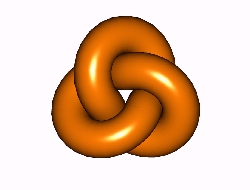

Symmetry of the ideal knots
In contradiction to our expectations, ideal knots as a rule do not have any symmetry elements. It seems, however, that there are a few exceptions. I wrote "it seems" on purpose. As a matter of fact, we still know very little about ideal knots. Numerical simulations provide us with some apparently most tight conformations. We calculate their parameters such as the average crossing number or writhe. But that is all. In a few cases we feel justified to believe that the conformation we have found is very close to the Ideal Conformation. Basing on this belief we may try to guess some properties of the latter, for instance its symmetry point group. And this is what I shall try to achieve below.
The ideal conformation is know for sure just but in one case - the unknot. The ideal unknot is a perfect circle. Thus, symmetry properties of the ideal unknot are known.
Let us consider the 31 (trefoil) knot. Tightening it with the SONO algorithm leads inevitably to a conformation, see figure below, the symmetry point group of which seems to be D3. (How to prove it?)


What about the 41 (figure eight) knot? Also here SONO algorithm ends with conformation of always the same kind, see figure above. As noticed by Vsevolod Katritch the ideal 41 knot has most probably the S4 symmetry point group . Let me demonstrate it.
Take the most tight conformation of the 41 knot found by the SONO algorithm, rotate it by 90 degrees and reflect it in a mirror plane perpendicular to the rotation axis. You will find that the result coincides with the initial conformation. Figure below clearly presents this.
(Ends of the rope on which
the knot is tied were not closed on purpose - the defect allows one to
see better symmetry operations.)